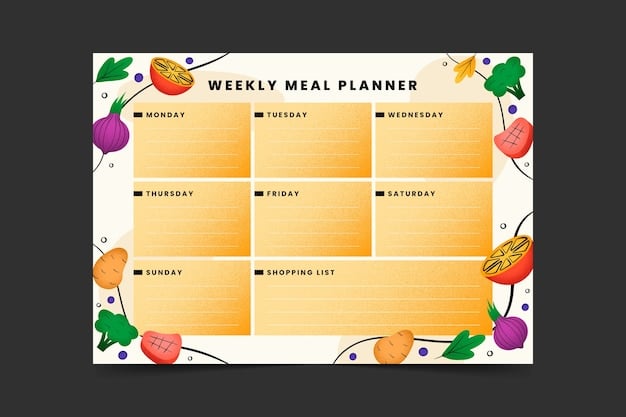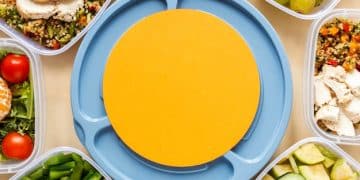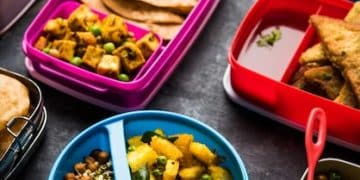Theme-Based Meal Planning: Your Ultimate Guide to Stress-Free Meals

The Ultimate Guide to Theme-Based Meal Planning: Save Time and Reduce Decision Fatigue offers a structured approach to simplify meal preparation by organizing your meals around specific themes, reducing decision fatigue and making grocery shopping more efficient.
Feeling overwhelmed by the endless “what’s for dinner?” question? The Ultimate Guide to Theme-Based Meal Planning: Save Time and Reduce Decision Fatigue is here to transform your meal prep routine, making it simpler, more enjoyable, and less stressful.
What is Theme-Based Meal Planning?
Theme-based meal planning is a strategic approach to organizing your weekly meals around specific themes. Instead of randomly picking recipes each day, you dedicate certain days to particular cuisines, ingredients, or cooking styles. This method simplifies the decision-making process, reduces grocery shopping time, and can even encourage you to try new recipes within a familiar framework.
Benefits of Theme-Based Meal Planning
Implementing theme-based meal planning offers numerous advantages. It streamlines your cooking routine and makes meal preparation less daunting. Here are some key benefits:
- Reduces Decision Fatigue: By predetermining the theme for each day, you eliminate the daily struggle of deciding what to cook.
- Saves Time: Planning meals around themes makes grocery shopping more efficient since you can group similar ingredients together.
- Encourages Variety: Theme-based planning can help you explore different cuisines and cooking methods, adding variety to your diet.
- Simplifies Cooking: When you focus on a specific theme, you can prep ingredients in advance, making weeknight cooking faster and easier.
Overall, theme-based meal planning is a practical way to create a structured, enjoyable, and efficient meal preparation system, making it easier to eat well and reduce daily stress.
Getting Started: Choosing Your Themes
The key to successful theme-based meal planning is selecting themes that resonate with your taste, lifestyle, and dietary preferences. Here’s how to choose themes that will work for you:
Consider Your Preferences
Start by listing your favorite cuisines and ingredients. Do you love Italian food? Are you a fan of tacos? Make a list of foods that you and your family enjoy. This will form the basis of your themes.
Think About Your Schedule
Reflect on your weekly schedule. Are there certain days when you have more time to cook? Are there days when you need something quick and easy? Tailor your themes to match your availability. For example, reserve more elaborate themes for weekends and simpler themes for weeknights.

Examples of Popular Themes
Here are some popular theme ideas to get you started:
- Meatless Monday: Focus on vegetarian or vegan dishes.
- Taco Tuesday: Enjoy a variety of Mexican-inspired recipes.
- Pasta Wednesday: Explore different pasta shapes and sauces.
- Throwback Thursday: Revisit childhood favorites.
- Fish Friday: Prepare seafood-based meals.
- Slow Cooker Saturday: Use your slow cooker for hands-off cooking.
- Sunday Roast: Enjoy a traditional roast dinner.
Choosing themes that align with your preferences and lifestyle will make meal planning more exciting and sustainable. Don’t be afraid to get creative and experiment with different combinations.
Planning Your Theme-Based Meals: A Step-by-Step Guide
Once you’ve selected your themes, it’s time to start planning your meals. A systematic approach will ensure that your meal plans are organized, balanced, and enjoyable.
Create a Weekly Template
Start by creating a simple weekly template with your chosen themes. This template will serve as the framework for your meal planning process. You can use a physical planner, a digital calendar, or a meal planning app.
Brainstorm Recipes
For each theme, brainstorm a list of potential recipes. Consider recipes that are easy to prepare, use ingredients you enjoy, and fit your dietary needs. Keep a running list of recipes for each theme to draw from each week.
Check Your Pantry and Fridge
Before finalizing your meal plan, take inventory of your pantry and fridge. Use up ingredients that are nearing expiration and plan your meals around what you already have on hand. This will reduce food waste and save you money.
By following these steps, you can create well-organized and effective theme-based meal plans that simplify your cooking routine and make meal preparation a breeze.

Grocery Shopping for Theme-Based Meals
Efficient grocery shopping is a crucial component of theme-based meal planning. By organizing your shopping list by theme, you can save time and minimize impulse purchases.
Organize Your List by Theme
Instead of listing ingredients randomly, group them by the theme of each meal. This will streamline your shopping trip and help you stay focused on what you need. For example, list all the ingredients for Taco Tuesday together.
Shop Once a Week
Try to do your grocery shopping once a week to save time and reduce the likelihood of impulse buys. A single, well-planned shopping trip ensures that you have everything you need for the week ahead.
Utilize Online Grocery Services
Consider using online grocery delivery or pickup services. These services can save you time and help you avoid impulse purchases. Simply add the ingredients to your cart based on your theme-based list and schedule a delivery or pickup.
Theme-based grocery shopping is all about planning and organization. By grouping ingredients by theme and sticking to your list, you can make your shopping trips more efficient and less stressful.
Overcoming Common Challenges
Even with the best planning, challenges can arise. It’s important to have strategies to deal with common issues that may disrupt your theme-based meal planning routine.
Dealing with Picky Eaters
If you have picky eaters in your family, involve them in the meal planning process. Let them suggest recipes within the chosen themes. This can increase the likelihood that they will enjoy the meals.
Adapting to Schedule Changes
Life happens, and schedules can change unexpectedly. If you find yourself short on time one day, be prepared to swap meals around or opt for a quick, easy alternative that still fits the theme.
Avoiding Theme Fatigue
To avoid getting bored with your themes, rotate them regularly. Introduce new themes every few weeks or months to keep things interesting. You can also try combining themes for a creative twist.
Addressing these challenges proactively will help you maintain a consistent and enjoyable theme-based meal planning routine. Remember, flexibility and creativity are key.
Advanced Tips and Tricks
Once you’ve mastered the basics of theme-based meal planning, you can explore advanced techniques to further streamline your meal preparation process and enhance your culinary experience.
Batch Cooking
Batch cooking involves preparing large quantities of staple ingredients or entire meals in advance. This can save you significant time during the week. For example, on a weekend, you could cook a large batch of rice, beans, or roasted vegetables to use in various meals throughout the week.
Theme-Based Meal Prep
Extend the theme concept to your meal prep activities. Dedicate a few hours each week to prepping ingredients according to your themes. Chop vegetables, marinate meats, and prepare sauces in advance to make weeknight cooking even faster.
Utilize Theme-Based Leftovers
Plan your meals to intentionally create leftovers that can be repurposed into new dishes. For example, leftover roasted chicken from Sunday Roast can be used in chicken tacos on Taco Tuesday or in a chicken salad on Meatless Monday (if you’re flexible with the theme!).
By incorporating these advanced tips, you can elevate your theme-based meal planning to a new level of efficiency and creativity. Embrace these strategies to transform your cooking routine and enjoy a variety of delicious, home-cooked meals.
| Key Point | Brief Description |
|---|---|
| 💡 Choose Themes | Select cuisines or ingredients you enjoy. |
| 🗓️ Plan Weekly | Create a template with themes for each day. |
| 🛒 Shop Smart | Organize your grocery list by theme. |
| ⏰ Batch Cooking | Prepare staple ingredients in large quantities ahead of time. |
Frequently Asked Questions
▼
Theme-based meal planning involves assigning specific themes to different days of the week, such as “Meatless Monday” or “Taco Tuesday,” to simplify meal selection and grocery shopping. It reduces decision fatigue by narrowing down your options.
▼
Consider your favorite cuisines, dietary preferences, and the amount of time you have available for cooking each day. Popular themes include specific cuisines (Italian, Mexican, Asian) or cooking methods (slow cooker, grilling).
▼
Benefits include reduced decision fatigue, more efficient grocery shopping, increased variety in your meals, and the ability to streamline meal preparation by focusing on specific ingredients or cooking styles each day.
▼
Involve picky eaters in the theme selection process and allow them to suggest recipes within the chosen themes. Offer variations of dishes that cater to their preferences while still aligning with the overall theme.
▼
Be flexible and prepared to swap meals around or opt for quick and easy alternatives that still fit the theme. Keep a list of simple recipes for each theme that you can prepare on short notice when needed.
Conclusion
Theme-based meal planning is a powerful tool to reclaim control over your kitchen and bring joy back to your dining table. By thoughtfully planning meals around engaging themes, you can significantly reduce stress, save valuable time, and enjoy a greater variety of delicious and satisfying meals. Embrace this guide, explore the endless possibilities, and bon appétit!





